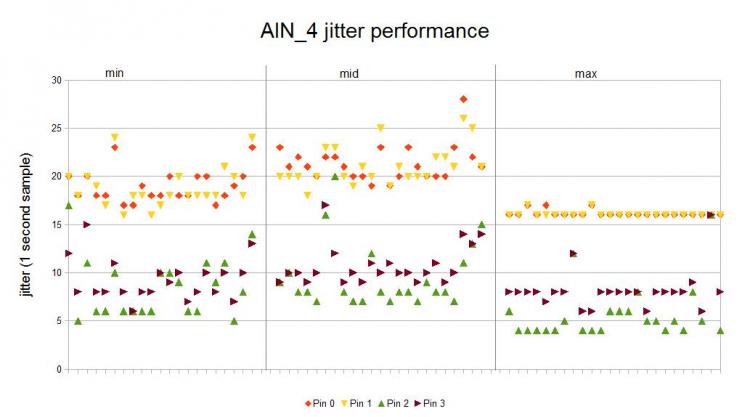-
Posts
2,524 -
Joined
-
Last visited
-
Days Won
149
Content Type
Profiles
Forums
Blogs
Gallery
Posts posted by latigid on
-
-
It could be a connection problem or it might just need configuration. Have a look here for the info:
http://www.ucapps.de/midibox16e.htmlI don't know how familiar you are with electronics/MIDIbox etc., but what you have is a grid of panel mounted encoders and switches, which are scanned by shift register "modules" stuffed with 74HC165 chips. These form the SRIO chain. The Core is the brain of the operation, and newer generations are not only backwards compatible and easier to configure, but are faster and offer more hardware options (increased MIDI IO, USB, OSC/Ethernet, SD storage, etc.). It's a whole new board though:
http://www.ucapps.de/mbhp_core_stm32f4.html -
Are any Banksticks installed?
http://www.ucapps.de/mbhp_bankstick.html
Judging from the wiring it's probably an MB64E. You could upgrade to a 32-bit Core, then the configuration and patch storage is easily done with SD cards.
-
-
-
I can work my way through French okay, feel free to post (could be useful to others also). I edited my post above with app_skeleton built and it works fine, maybe try that on your Win10? That might narrow it down.
-
Okay, I just built app_skeleton and I get recognition of the USB MIDI device afterwards.
You can try with my version if you like (attached).
-
If you like I can try to compile here on my environment -- can you list the dependencies? (SVN?)
-
Hi, I get the same behaviour with no valid MIDI devices installed after firmware update via MIOS Studio. I have no problem with any of the other MIDIbox stuff (NG, CV, SEQ, diagnostics etc.). Hope that you can locate the issue!
Best,
Andy -
I've never built a SID module (just the MB-6582), but the MBHP module only takes one chip, so yes you need an additional one if you want a stereo pair controlled by one Core8. Just write to Mike and see how he can help with PCBs.
For your own solution, I'd say that would be possible and you would get some interest. You just have to follow the schematics on uCapps and combine the modules rather than interconnecting them with cables.
Before selling PCBs, you must prove the concept first. But with a prototyping batch (e.g. 10 boards) it's generally okay to sell the extras that you don't need.
-
"MIDIbox SID 8580 / 6581 + CS" is the SID
kitset on Mike's site that you want. I think he still provides PCBs and PICs, possibly other parts but I don't know.You can also get PCBs and source your own parts. Where you buy from depends on your location. If in the US or nearby try http://midibox-shop.com/
Note you have to build your own control surface linking the DIN (digital inputs = switches and encoders) and DOUT (digital outputs = LEDs). It's more of a classic MIDIbox this way. You can choose how complicated to build based on your skills, time etc.
http://www.ucapps.de/midibox_sid_cs.html
-
http://www.ucapps.de/midibox_sid_manual_hw.html
That shows you everything you need to build your own SID. If you want a more compact solution, it's on you.
-
You can find layouts for SID, PIC8 Core, DIN, DOUT and so on on http://www.ucapps.de/. With these files you're welcome to make your own PCBs for personal use, and they've been there for at least a decade.
Maybe you want to clone the MBSID for commercial reasons, maybe you want to just etch your own boards at home. But the easy answer for you is: no one is going to give you design files for sammichSID or a complete project like it. But if you're interested and have skills to make boards, maybe you can come up with a similar project. I'm sure there'll be many people interested :).
-
If you like, attach the .hex and I can try it over here.
FWIW, did you try updating the ST LINK firmware to LINK007? I know with older firmwares on newer DISCOVERY boards it can have trouble with USB when the mini USB side is disconnected (I've posted that in various threads over the last couple of days).
Win10 can also have issues with MIDI drivers. Also note on MIOS32_download:
Quotemidibox.org_gm5_WIN32_1.0.10.zip USB MIDI driver for 32bit Windows. Especially recommended for MIOS32 applications which provide more than 1 USB MIDI Port for robust SysEx transfers. Also provides multi client capability and improved performance.
Details about this driver can be found at the MBHP_USB_GM5 page.
Note that for MacOS and Linux no special driver is required!
The GM5 driver is currently not supported for the MBHP_CORE_STM32F4 module, but it's planned to provide it in future!midibox.org_gm5_X64_1.0.10.zip USB MIDI driver for 64bit Windows. -
Instead of soldering jumpers etc., try upgrading the "bootloader" firmware to LINK007. This solves the issue of the STM32F407 chip being held in reset when the mini USB isn't plugged in.
-
And another update (might be good to merge the threads); if you install the Link007 firmware, the problem disappears with no hardware fixes needed.
-
In fact, it's easier than this. ST released a new firmware for ST LINK (STSW-LINK007) that removes the requirement for USB host to be present. If your device exhibits problems, try upgrading the firmware (mini USB side). It only deals with the "bootloader" side; it's not necessary to re-flash the F407 chip.
-
Okay, just to close the loop, I noticed an error behaviour:
So it seems as if the newest DISCO boards aren't exactly the same, but this simple fix of removing two links restores the expected functionality.
-
Nice job!
I managed to do it the old fashioned way the other evening, just setting environment variables by hand and invoking "make" from the project directory. But this looks easy enough for anyone to try :). With Eclipse are you able to set different "presets" for distinct build environments? I know you can run into trouble with multiple toolchains etc.
-
Today I experienced the same behaviour on my board marked MB997D. The fix noted above works perfectly, just remove link SB11 and resistor R68 (100R). Both are on the underside of the Discovery board. LED1 now blinks red (perceived lack of USB host I assume), but it still boots into ST LINK okay (I didn't try flashing the bootloader).
Maybe to clarify: I had already gone through the MIOS bootloader process, but afterwards, unless the mini USB (ST LINK side) was connected the computer wouldn't recognise the micro USB, i.e. it wouldn't show up as a MIDI device in MIOS Studio. This confirms the poster's theory that an absence of USB on the ST LINK side holds the board in reset. SB11 and R68 are still present on the MB997C revision and I can't see any other layout or jumper configuration differences, so it must be down to firmware (?) on the STM32F1 side. No problems here using an LCD on J15A.
I don't recommend bridging SB10, because that will negate the effect of a power on reset (pin is low while capacitor C11 charges) and also renders the RESET button useless.
-
Hi, somehow I missed your post.
I'd make the following points about your design:
- Ground scheme/trace layout isn't the best, the digital stuff has free reign to interfere with the analogue by way of coupling through the top layer plane.
- Some quite thin traces (10mil), going through capacitors and the like.
- Power connector is non-standard (suggest a Eurorack 2*5 DIL or polarised Molex SIL). Also note that the "digital power and ground" comes in on J19 (CONN1 on your layout); but I notice jumpers for connecting/disconnecting these.
In the meantime I've come up with my own solution:
It's a four-channel board and uses two quad op amps for this. But you get range and offset switching plus a fine tune control out of the box. It stacks with an associated control board with 3.5mm jacks that also carries DOUT gates and indicator LEDs. To be honest, I think the switching can be done manually, presumably as you re-patch at the same time anyway. While it could be done with a digital IC (or FET perhaps?) the risk is that you inject digital noise into the sensitive analogue summing node (op amp inverting input). My concept also uses a switch pole to add/remove a resistor from one op amp stage, which varies the gain. This would be expensive (and a bit risky in terms of noise) with an analogue switch IC. Maybe vactrols would work :), but I made do with mini DPDT switches and indicator LEDs.
@Altitude also did a fully SMT version with eight channels, all DOUT gates, extra triggers and clocks on the one board.
To be honest, I'm not sure how much interest there is in these MAX525 boards. I think the price of the DAC puts people off, even though it has better linearity than TLV5630. If users are keen I'll do a run of them, otherwise I get personalised CV for myself :).
Best,
Andy -
I loaded up ain_jitter_mon to check the performance of AIN_4:
Test conditions are a 5V reference into the input (normalisation), attenuation of this to min/mid/max using the on board pot (this pot doesn't go all the way to 0V/ground to protect the TL072 op amp output). AIN4-7 are jumpered to ground at the Core.
Each point is a 1 second sample with the difference between maximum and minimum value plotted. ADC resolution is full 12-bit, so even with a jitter of 20 it's ~0.5% error. I think that'll probably be acceptable with CV inputs that are changing over time. Apparently there's also the possibility of oversampling.
For reference, the figures look pretty similar to simply connecting a pot to 0V/3v3, so my guess is that the STM chip is the main culprit for noisy ADCs :).
-
Aha, might have been indeed! Thanks muchly for the insight.
-
Probably unrelated, but I'll mention it -- the other day I was trying to create a new file via MIOS Studio File Browser called "AOUT_TEST.NGC" and it wouldn't let me. But I could create a file called "AOUT.NGC" Apparently this SD card has some corrupt sectors on it (when used in a camera), so it might work better on a different SD?

-
Hmm, I think Altium will cost you over 9000 dollars, unless you're a student. There are cheaper options like EAGLE (freeware up to a certain PCB area), KiCAD (free and open), Diptrace etc.
All CAD software has steep learning curves. Plenty of fabs to get your boards done all around the world. Where are you located? If you're planning large boards, they won't be cheap and you'll have to buy multiple copies. Modulbox is a preliminary ideas page from @Psykhaze. I'm sure he'd be happy to discuss with you if there are common points of interest.





Problem, w patchmode
in MIDIbox HUIs
Posted
http://midiboxshop.bigcartel.com/product/core-stm32f4-board-kit
No need to breadboard. IMO this is almost the simplest MBHP to build and there's very little to go wrong.
Maybe see how you go with the 8-bit and if it's too hard consider a Core upgrade as a solution.
Good luck!